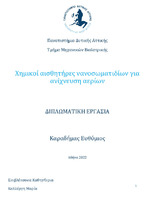| dc.contributor.advisor | Kallergi, Maria | |
| dc.contributor.author | Καραδήμας, Ευθύμιος | |
| dc.date.accessioned | 2022-10-13T13:11:03Z | |
| dc.date.available | 2022-10-13T13:11:03Z | |
| dc.date.issued | 2022-10-07 | |
| dc.identifier.uri | https://polynoe.lib.uniwa.gr/xmlui/handle/11400/3071 | |
| dc.identifier.uri | http://dx.doi.org/10.26265/polynoe-2911 | |
| dc.description.abstract | Η παρούσα διπλωματική εργασία είχε ως σκοπό να μελετήσει την ανίχνευση πτητικών
οργανικών ενώσεων, οι οποίες συνιστώνται ως συστατικά σε κοινά φυτοφάρμακα. Η ανίχνευση
αυτή πραγματοποιήθηκε με χρήση διάταξης νανοσωματιδίων πλατίνας, και πολυμερών. Οι
χημικοί αισθητήρες αερίων στοχεύουν στην ανίχνευση συγκεκριμένων μορίων ενός αερίου
στόχου και πολλές φορές χαρακτηρίζονται ως ηλεκτρονικές μύτες (e-noses). Η προσρόφηση και
η διάχυση αεριών από τα πολυμερή και οι μηχανισμοί αγωγιμότητας που διέπουν τα
νανοσωματίδια, καθιστούν τις διατάξεις αυτές κατάλληλες για τα συγκεκριμένα πειράματα.
Οι αισθητήρες που χρησιμοποιήθηκαν για τα πειράματα αποτελούνται από νανοσωματίδια
πλατίνας, υποστρώματα πυριτίου και πολυμερή. Ως αισθητήρια υμένια χρησιμοποιήθηκαν τα,
ευαίσθητα στα αέρια, πολυμερή Pema, Phema, Pibma, Pbma. Οι μετρήσεις αποσκοπούσαν στην
ανίχνευση του αερίου φυτοφαρμάκου σε περιβάλλον σχετικής υγρασίας. Η υπό ανίχνευση
ουσία καθώς και η αναφορά, βρίσκονταν σε υδατική μορφή από την οποία παραλαμβάνονται
οι ατμοί μέσω αερίου αζώτου. Τα πιο σημαντικά στοιχεία της διάταξης ήταν οι ελεγκτές ροής
αζώτου, η αισθητήριες διατάξεις, το ηλεκτρόμετρο καθώς και τα δοχεία bubblers. Αφού
συντέθηκε το φυτοφάρμακο, οι μετρήσεις πραγματοποιήθηκαν σε δύο περιβάλλοντα
θερμοκρασίας και σε τρία διαφορετικά υπόβαθρα υγρασίας για τις τέσσερεις αισθητήριες
διατάξεις.
Πραγματοποιήθηκε καταγραφή της αρχικής και τελικής τιμής αντίστασης για ροή
φυτοφαρμάκου και υγρασίας και στην συνέχεια υπολογίστηκε ο λόγος μεταβολής αντίστασης
και αρχικής αντίστασης. Παρατηρήθηκε ότι η αντίσταση των διατάξεων αυξάνεται ανάλογα με
την αύξηση των ποσοστών σχετικής υγρασίας. Ακόμη, η απόκριση των αισθητήρων σε ατμούς
φυτοφαρμάκου και υγρασίας διαφοροποιείται πιο έντονα σε υψηλότερα ποσοστά σχετικής
υγρασίας του περιβάλλοντος και ιδιαιτέρα στις συνθήκες θερμοκρασίας των 35 °C
Συνεπώς, η χρήση των συγκεκριμένων χημικών διατάξεων μπορεί να αποβεί χρήσιμη στην
ανίχνευση φυτοφάρμακου σε περιβάλλον σχετικής υγρασίας. Ένας από τους στόχους της
μελέτης ήταν να αξιολογηθεί η χρήση του αισθητήρα και να διαπιστωθεί αν είναι ικανός να
χρησιμοποιηθεί σε εφαρμογές στο πεδίο της γεωργίας. Εφόσον η διάκριση πραγματοποιήθηκε
επιτυχώς, η διάταξη θα μπορούσε να χρησιμοποιηθεί για ανίχνευση συγκεκριμένων ουσιών,
παρόμοιας φύσεως, η οποίες συνιστούν βιοδείκτες, λαμβάνοντας υπόψιν τους σχετικούς
περιορισμούς. | el |
| dc.format.extent | 90 | el |
| dc.language.iso | el | el |
| dc.publisher | Πανεπιστήμιο Δυτικής Αττικής | el |
| dc.rights | Αναφορά Δημιουργού - Μη Εμπορική Χρήση - Παρόμοια Διανομή 4.0 Διεθνές | * |
| dc.rights | Attribution-NonCommercial-NoDerivatives 4.0 Διεθνές | * |
| dc.rights.uri | http://creativecommons.org/licenses/by-nc-nd/4.0/ | * |
| dc.subject | Νανοτεχνολογία | el |
| dc.subject | Nανοϋλικά | el |
| dc.subject | Αισθητήρες | el |
| dc.subject | Χημικός αισθητήρας αερίων | el |
| dc.subject | Νανοσωματίδια | el |
| dc.subject | Πολυμερή | el |
| dc.subject | Ηλεκτρονικές μύτες | el |
| dc.subject | Φυτοφάρμακα | el |
| dc.subject | Σχετική υγρασία | el |
| dc.subject | Ροή αζώτου | el |
| dc.subject | Ανάλυση PCA | el |
| dc.subject | Βιοαισθητήρες | el |
| dc.subject | Βιοδείκτες | el |
| dc.subject | Εκπνεόμενα αέρια | el |
| dc.title | Χημικοί αισθητήρες νανοσωματιδίων για ανίχνευση αερίων | el |
| dc.title.alternative | Chemical sensors of nanoparticles for gas detection | el |
| dc.type | Διπλωματική εργασία | el |
| dc.contributor.committee | Matsoukas, Minos-Timotheos | |
| dc.contributor.committee | Skotadis, Evangelos | |
| dc.contributor.faculty | Σχολή Μηχανικών | el |
| dc.contributor.department | Τμήμα Μηχανικών Βιοϊατρικής | el |
| dc.description.abstracttranslated | The purpose of this thesis was to examine the detection of volatile organic compounds, which
are used as ingredients in common pesticides. This detection was made using an array of
platinum nanoparticles and polymers. Chemical gas sensors aim to detect specific molecules of
a target gas and are often referred to as electronic noses. The adsorption and diffusion of gas by
polymers and conduction mechanisms of nanoparticles, has made these devices suitable for
specific experiments.
The sensor consists of platinum nanoparticles, silicon substrates and polymers. The gas sensitive polymers Pema, Phema, Pibma, Pbma were used as the sensors’ film. The
measurements aimed to distinguish between two gases, one of which is the reference. In this way
it was possible to recognize the substance of the pesticide. The substance under detection, as
well as the reference substance, were in aqueous form from which the vapors were collected
through nitrogen gas. The most important elements of the setup were the mass flow controllers,
the sensing devices, the electrometer and the bubblers. After the pesticide was synthesized,
measurements were performed in two temperature environments and three humidity
backgrounds regarding four sensing devices.
The initial and final resistance values for pesticide and moisture flow were recorded. After
this, the ratio of resistance change to initial resistance was calculated. The resistance of the
devices increases as the percentage of relative humidity increases. The response of sensors to
pesticide vapors and moisture differs strongly at higher relative humidity of the environment
and especially at the temperature of 35 °C
Therefore, the use of specific chemical devices can be useful in the detection of pesticide in a
relative humidity environment. One of the goals of the study was to evaluate the performance of
the sensor and determine if it can be used in applications in the field of agriculture. Once the
distinction was successfully made, the device could be also used to detect specific substances, of
a similar nature, which constitute biomarkers, taking into account the relevant limitations. | el |


